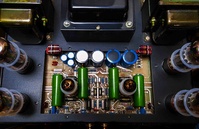My ST-70 had a very similar issue. I tried all of the troubleshooting I could do before sending it back to Bobs Technician. It was a bad bias pot, he replaced and all good since.
+8
BCROW
mrnik0
Dale Stevens
Rbertalotto
ericoto
ttocs
Brap
Peacemaker
12 posters
Help with new to me ST-120 Stereo Amplifier - Scratchy noise in right channel

valgolfs- Posts : 1
Join date : 2018-04-29

Tuninfork- Posts : 6
Join date : 2015-07-26
I think Bob probably hit the issue right on. If output tubes are balance reasonably or one is not functioning at all, you will see significantly lower volume from that channel. Another thing that someone mentioned is the issue of cold soldered joints. When I get a piece of equipment in for restoration, first all controls and switches get cleaned, the tubes are checked, filter caps addressed, and then ALL solder joints get reheated and touched up. About 80% of the time the amp will function well enough for me to measure voltages and diagnose any additional problems. Old equipment with carbon comp resistors are very prone to drift and internal noise. If you are very careful you can have the amp powered up and operating and use a bamboo or plastic chopstick to tap on each resistor. You can very quickly find the noisey part. Please be careful and do not have amp connected to your expensive speakers!
ttocs likes this post

Peacemaker- Posts : 11
Join date : 2021-12-10
Bob Latino wrote:Peacemaker wrote:I also just tested the bias on all four power tube sockets and three read .500 and the one on the right rear fluctuates between 14.00 and 17.00. I then tried swapping tubes and get the same reading from that socket, which tells me that it's not a tube issue, right? What could it be then?
Check to see if the 10 ohm 2 watt resistor that goes from pins 1 and 8 on the right rear socket does still measure about 10 ohms. If any tube will not bias in that socket, this is usually a sign that this resistor is bad. You can check the value of this 10 ohm resistor without even taking the bottom cover off the amp. Make sure that the amp is OFF and measure the RESISTANCE to chassis ground at all four bias measuring points. You should get about 10 ohms at all four bias measuring points. See if the right rear socket measures significantly different than the other three sockets.
Bob
Mr. Latino - Thank you so much for your help and time with my problem! I followed your suggestion and tested the sockets. The socket in question measures "1' when I test it and the other three measure 10.1 which indicates that the resistor is probably bad, as you suggested. Where can a laymen such as myself source a replacement resistor?

Bob Latino- Admin
- Posts : 3276
Join date : 2008-11-26
Location : Massachusetts
You can get 5 pieces very inexpensively at the Ebay link below. Be sure to select 10 ohms from the drop down menu.
Ebay link to 10 ohm 2 watt resistors
Bob
Ebay link to 10 ohm 2 watt resistors
Bob

Peacemaker- Posts : 11
Join date : 2021-12-10
Just ordered a set of these and looking forward to installing the new resistor and getting my amp back in service. I'll post back here with results once It's replaced.
Thank you Mr. Latino and to everyone else for all of your help!
Thank you Mr. Latino and to everyone else for all of your help!
Donspokane likes this post

MechEngVic- Posts : 107
Join date : 2019-01-16
Here's a simple troubleshoot you can try: With the amp on and warmed up, tap or flick the tubes, wiggle them around in their sockets (use a rag and be very gentle!). You can also use a thin wood dowel or chopstick to tap on capacitors and resistors. If you tap on a problem component, the scratchy sound may be amplified. Lowered volume on one channel sounds like a resistor.
Sponsored content

